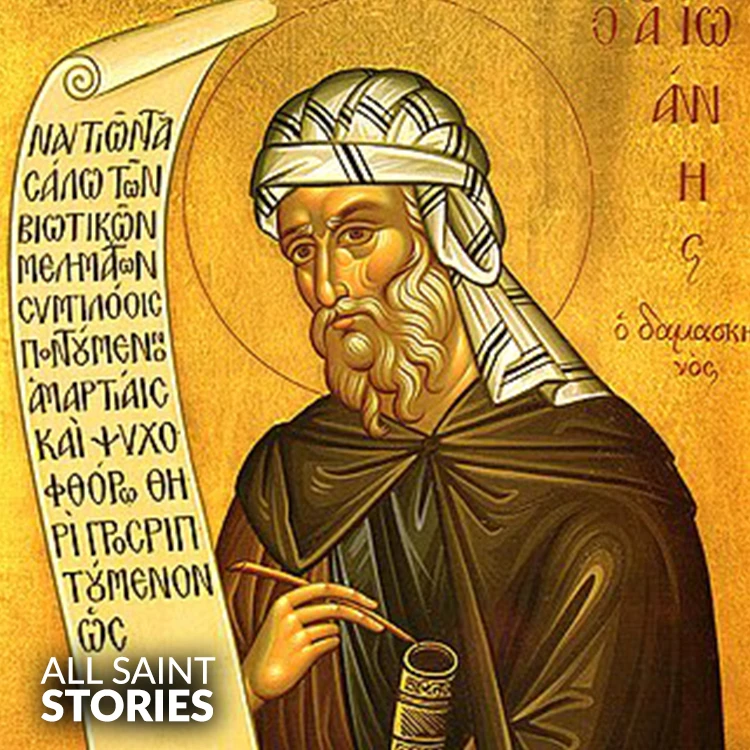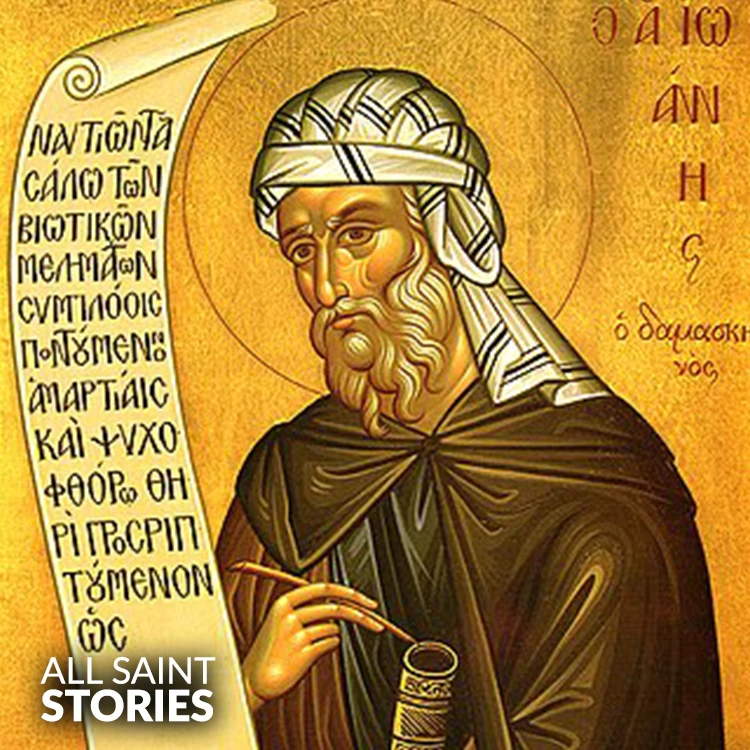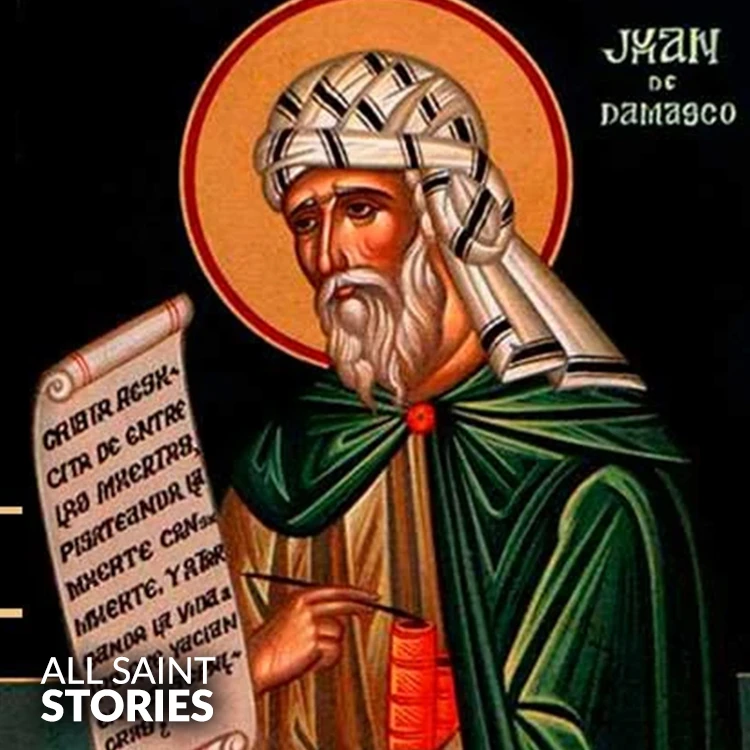O holy St. John Damascene, Defender of the faith and lover of truth, Guide us in wisdom and understanding. Help us to honor God with pure hearts And to seek His will in all we do. Intercede for us, that we may grow in faith And remain steadfast in His love. Amen.
ST. JOHN DAMASCUS
ST. JOHN DAMASCUS

St. John Damascene (676–749) was a prominent Christian theologian and a Doctor of the Church. He is best known for his defense of the veneration of icons against the Iconoclasts and for his clear articulation of the nature of Christ. His work on the Trinity, Christology, and the use of religious images deeply influenced the development of Orthodox theology.
St. John Damascene, also known as John of Damascus, was born in Damascus, which was part of the Umayyad Caliphate during the 7th century. He came from a prominent Christian family with his father holding a high governmental position under the Caliph. After his father’s death, John succeeded him in the civil service but soon left his secular position to devote himself to religious life at the Monastery of St. Sabas near Jerusalem. There, he became a monk and a prolific theologian.
John’s theological contributions are vast, but he is most renowned for his defense of the veneration of icons. During his lifetime, the Church was embroiled in the controversy of Iconoclasm, which sought to eliminate the use of religious images in the Byzantine Empire. Many church leaders and emperors, influenced by Islamic and other heretical ideas, denounced the use of icons as idolatry. However, St. John Damascene argued against these claims, asserting that icons were an important means of expressing Christian faith, and they venerated the prototype—Christ and the saints—without idolizing the image itself. He famously defended this position in his work "Exposition of the Orthodox Faith", where he laid out a thorough argument for the legitimacy of icon veneration.
In addition to his defense of icons, St. John was also a key figure in the clarification of Christian doctrine. His writings on the nature of Christ and the Trinity played an essential role in preserving the orthodox Christian understanding of the Incarnation. He emphasized the dual nature of Christ—both fully human and fully divine—without confusion or separation. This theological stance was critical in combating heresies such as Monophysitism and Nestorianism, which misunderstood or misrepresented the relationship between Christ’s divine and human natures. His works on the Trinity also offered profound insights into the relationship between the Father, the Son, and the Holy Spirit, which solidified the orthodox doctrine of the Trinity.
St. John Damascene was deeply influenced by Aristotelian logic and philosophy, incorporating these philosophical methods into his theological writings. He saw philosophy as a tool to better understand and explain Christian teachings, using reason to articulate the mysteries of faith in a way that was both intellectual and accessible.
His writings were not limited to theological debates. He also contributed to a broader understanding of Christianity through his apologetics, which included refutations of various heresies, and he composed several works on Christian ethics, morality, and the path to salvation. His works served as a bridge between Eastern and Western Christian thought and significantly impacted the development of Byzantine and Latin theology.
John’s theological legacy continued to have a profound influence throughout the medieval period and into the Renaissance. The Seventh Ecumenical Council (Second Council of Nicaea) in 787, which restored the veneration of icons in the Church, was heavily influenced by his writings. The Council affirmed his arguments, declaring that icons were a legitimate part of Christian practice, not an affront to God, and that they could help believers focus on the divine.
St. John Damascene died in 749, and he was buried in the Monastery of St. Sabas in Jerusalem. He was later declared a Doctor of the Church due to his outstanding contributions to Christian theology and doctrine. His feast day is celebrated on December 4th in both the Roman Catholic and Eastern Orthodox Churches.
Video Not Found
The information on this website is compiled from various trusted sources. While we aim for accuracy, some details may be incomplete or contain discrepancies.
If you notice any errors or have additional information about this saint, please use the form on the left to share your suggestions. Your input helps us improve and maintain reliable content for everyone.
All submissions are reviewed carefully, and your personal details will remain confidential. Thank you for contributing to the accuracy and value of this resource.
Credits & Acknowledgments
- Anudina Visudhar (Malayalam) – Life of Saints for Everyday
by Msgr. Thomas Moothedan, M.A., D.D. - Saint Companions for Each Day
by A. J. M. Mausolfe & J. K. Mausolfe - US Catholic (Faith in Real Life) – Informational articles
- Wikipedia – General reference content and images
- Anastpaul.com – Saint images and reflections
- Pravachaka Sabdam (Malayalam) – Saint-related content and insights
We sincerely thank these authors and platforms for their valuable contributions. If we have unintentionally missed any attribution, please notify us, and we will make the correction promptly.
If you have any suggestion about ST. JOHN DAMASCUS
Your suggestion will help improve the information about this saint. Your details will not be disclosed anywhere.
© 2025 Copyright @ www.allsaintstories.com




 English
English
 Italian
Italian
 French
French
 Spanish
Spanish
 Malayalam
Malayalam
 Russian
Russian
 Korean
Korean
 Sinhala
Sinhala
 Japanese
Japanese
 Arabic
Arabic
 Portuguese
Portuguese
 Bantu
Bantu
 Greek
Greek
 German
German
 Dutch
Dutch
 Filipino
Filipino